Design and Performance Analysis of Dry Gas Fishbone Wells for Lower Carbon Footprint
Abstract
:1. Introduction
2. Background
3. Simulation Model Description
4. Model Elaboration
4.1. Analytical IPR Model for Fishbone Well
4.1.1. Number of Branches
4.1.2. Length of Branches
4.1.3. Permeability Anisotropy
4.1.4. Distance between Adjacent Branches
- Drainage surface:
- High-pressure reservoir effect:
4.2. IPR Empirical Correlation for Fishbone Well
4.3. IPR Data-Driven Models for Fishbone Well
4.3.1. Artificial Neural Network (ANN)
4.3.2. SVR Optimized by the Genetic Algorithm (SVR-GA)
5. Models Comparison and Validation
5.1. Number of Branches
5.2. Length of Branches
5.3. Permeability Anisotropy
5.4. Distance between Adjacent Branches
6. Conclusions
Author Contributions
Funding
Data Availability Statement
Acknowledgments
Conflicts of Interest
Appendix A
- Steady-state flow model for vertical well
- Transient flow model for horizontal well
- Steady-state flow model for horizontal well
Appendix B
References
- Lyu, Z.; Song, X.; Geng, L.; Li, G. Optimization of multilateral well configuration in fractured reservoirs. J. Pet. Sci. Eng. 2019, 172, 1153–1164. [Google Scholar] [CrossRef]
- Elyasi, S. Assessment and evaluation of degree of multilateral well’ s performance for determination of their role in oil recovery at a fractured reservoir in Iran. Egypt. J. Pet. 2016, 25, 1–14. [Google Scholar] [CrossRef] [Green Version]
- Chen, D.; Pan, Z.; Liu, J.; Connell, L.D. Characteristic of anisotropic coal permeability and its impact on optimal design of multilateral well for coalbed methane production. J. Pet. Sci. Eng. 2012, 88–89, 13–28. [Google Scholar] [CrossRef]
- Sobhaniaragh, B.; Trevelyan, J.; Mansur, W.J.; Peters, F.C. Numerical simulation of MZF design with non-planar hydraulic fracturing from multilateral horizontal wells. J. Nat. Gas Sci. Eng. 2017, 46, 93–107. [Google Scholar] [CrossRef] [Green Version]
- Yu, F.; Huang, G.; Ni, H.; Zhen Nie Li, W.; Li, J.; Jiang, W. Analysis of the main factors affecting bottom hole assembly Re-entry into main hole in forward drilling of Fishbone wells. J. Pet. Sci. Eng. 2020, 189, 107018. [Google Scholar] [CrossRef]
- Busahmin, B.; Saeid, N.H.; Alusta, G.; Zahran, E.-S.M.M. Review on hole cleaning for horizontal wells. ARPN J. Eng. Appl. Sci. 2017, 12, 4697–4708. [Google Scholar]
- Fan, Y.; Han, G.; Yang, C. Production forecast for herringbone well and optimum configuration of lateral holes. Acta Pet. Sin. 2006, 27, 101–104. [Google Scholar]
- Xing, G.; Guo, F.; Song, C.; Sun, Y.; Yu, J.; Wang, G. Fishbone Well Drilling and Completion Technology in Ultra-Thin Reservoir. In Proceedings of the IADC/SPE Asia Pacific Drilling Technology Conference and Exhibition, Tianjin, China, 9–11 July 2012. Paper IADC/SPE 155958. [Google Scholar] [CrossRef]
- El Ghandour, M. The Fishbone Technology: To Use or Not to Use. Egypt Oil & Gas. 2021. Available online: https://egyptoil-gas.com/features/the-fishbone-technology-to-use-or-not-to-use/ (accessed on 20 January 2022).
- Sennaoui, B.; Pu, H.; Rylander, E.; Afari, S.; Malki, M.L. An Experimental Study of CO2 Huff-N-Puff Enhanced Oil Recovery in Three Forks Formation, Williston Basin. In Proceedings of the 56th U.S. Rock Mechanics/Geomechanics Symposium, Santa Fe, NM, USA, 26–29 June 2022. [Google Scholar] [CrossRef]
- Fishbone AS Company Website. 2022. Available online: https://www.fishbones.as/ (accessed on 2 January 2023).
- Alexeyev, A.; Ostadhassan, M.; Bubach, B.; Boualam, A.; Djezzar, S. Integrated reservoir characterization of the Middle Bakken in the Blue Buttes Field, Williston Basin, North Dakota: Society of Petroleum Engineers. In Proceedings of the SPE Western Regional Meeting, Bakersfield, CA, USA, 23–27 April 2017. [Google Scholar] [CrossRef]
- Khetib, Y.; Rasouli, V.; Rabiei, M.; Chellal, H.A.K.; Abes, A.; Bakelli, O.; Aoun., A.E. Modelling Slugging Induced Flow Instabilities and its Effect on Hydraulic Fractures Integrity in Long Horizontal Wells. In Proceedings of the 56th U.S. Rock Mechanics/Geomechanics Symposium, Santa Fe, NM, USA, 26–29 June 2022. [Google Scholar] [CrossRef]
- Ouadi, H.; Mishani, S.; Rasouli, V. Applications of Underbalanced Fishbone Drilling for Improved Recovery and Reduced Carbon Footprint in Unconventional Plays. Pet. Petrochem. Eng. J. (PPEJ) 2023, 7. [Google Scholar] [CrossRef]
- Stalder, J.L.; York, G.D.; Kopper, R.J.; Curtis, C.M.; Cole, T.L.; Copley, J.H. Multilateral-Horizontal Wells Increase Rate and Lower Cost Per Barrel in the Zuata Field, Faja, Venezuela. In Proceedings of the SPE International Thermal Operations and Heavy Oil Symposium, Porlamar, Venezuela, 12–14 March 2001. [Google Scholar] [CrossRef]
- Bazitov, M.V.; Golovko, I.S.; Konosov, D.A.; Mingazov, A.N.; Nigmatullin, R.R.; Lokot, A.V.; Malyasov, V.Y. First Fishbone well drilling at Vankorskoe field. In Proceedings of the Society of Petroleum Engineers—SPE Russian Petroleum Technology Conference, Moscow, Russia, 26–28 October 2015. [Google Scholar] [CrossRef]
- Voronin, A.; Gilmanov, Y.; Eremeev, D.; Dubrovin, A.; Abaltusov, N.; Perunov, A. An analysis of rotary steerable systems for sidetracking in open hole Fishbone multilateral wells in vostochno-messoyakhskoye field. In Proceedings of the Society of Petroleum Engineers—SPE Russian Petroleum Technology Conference, Moscow, Russia, 16–18 October 2017. [Google Scholar] [CrossRef]
- Akhmetov, M.; Maximov, M.; Lymarev, M.; Malyshev, Y.; Vasilyev, R.; Glushenko, N.; Rakhmangulov, F.; Denis, F. Drilling Extended Reach Well with Eight Fishbone Sidetracks: East Messoyakha Field. In Proceedings of the SPE Russian Petroleum Technology Conference, Moscow, Russia, 22–24 October 2019. [Google Scholar] [CrossRef]
- Lezin, A.; Kharitonov, A.; Seminikhin, I.; Korsunov, E.; Gassan, A.; Tikhonov, E.; Jadan, G.; Stashko, V.; Blagonadeshniy, I.; Manikhin, A.; et al. Adaptable drilling fluid system assisted in successful drilling of Taml 2 nine-hole horizontal well in vankor field. In Proceedings of the Society of Petroleum Engineers—SPE Russian Petroleum Technology Conference, Moscow, Russia, 22–24 October 2019. [Google Scholar] [CrossRef]
- Rylance, M.; Tuzov, Y.; Aliyev, S.; Gorbov, A.; Galitskiy, I.; Makhmutov, D.; Grinchenko, V.; Sultanov, R.; Levanov, I. Fishbones, wishbones and birch-leaves, multilateral well design on the srednebotuobinskoye field in eastern Siberia. In Proceedings of the Society of Petroleum Engineers—SPE Russian Petroleum Technology Conference, Virtual, 26–29 October 2020. [Google Scholar] [CrossRef]
- Rachapudi, R.V.; Al-Jaberi, S.S.; Al Hashemi, M.; Punnapala, S.; Alshehhi, S.; Talib, N.; Loayza, A.F.; Al Nuimi, S.; Elbekshi, A.; Quintero, F.; et al. Fishbone Stimulation a Game Changer for Tight Carbonate Productivity Enhancement, Case Study of First Successful Implementation at Adnoc Onshore Fields. In Proceedings of the Abu Dhabi International Petroleum Exhibition & Conference, Abu Dhabi, United Arab Emirates, 9–12 November 2020. [Google Scholar] [CrossRef]
- Quintero, F.; Talib, N.; Jimenez, A.; Chehabi, W.; Ramarao, S.; Al Nuami, M.A.; Al Reyami, M.; Hapa, C.; Edward, R. First Successful Fishbone Stimulation Completion in Onshore Oil Field in the United Arab Emirates. In Proceedings of the Abu Dhabi International Petroleum Exhibition & Conference, Abu Dhabi, United Arab Emirates, 9–12 November 2020. [Google Scholar] [CrossRef]
- Ozdemirtas, M.; McGinn, T.; Mejia, J.; McLennan, R.; Lopez, J. Innovative Fishbone SAGD Well Pair: An Integrated Approach to Efficiently Unlock the Resource Potential in Canadian Oil Sands Play. In Proceedings of the SPE/IADC Drilling Conference and Exhibition, London, UK, 17–19 March 2015. [Google Scholar] [CrossRef]
- Donnelly, J.K. Application of Steam Assisted Gravity Drainage (SAGD) to Cold Lake. In Proceedings of the SPE/CIM 6th One-Day Conference on Horizontal Well Technology, Calgary, AB, Canada, 12 November 1997; Paper CIM 97-192. Available online: https://www.osti.gov/etdeweb/biblio/595779 (accessed on 20 January 2022).
- Farouq-Ali, S.M. Is There Life After SAGD? J. Can. Pet. Technol. 1997, 36, 21–23. [Google Scholar] [CrossRef]
- Owusu, P.A.; DeHua, L.; Nyantakyi, E.K.; Nagre, R.D.; Borkloe, J.K.; Frimpong, I.K. Prognosticating the Production Performance of Saturated Gas Drive Reservoir: A Theoretical Perspective. Int. J. Min. Eng. Miner. Process. 2013, 2, 24–33. [Google Scholar] [CrossRef]
- Lu, J. New Productivity Formulae of Horizontal Wells. J. Can. Pet. Technol. 2001, 40. [Google Scholar] [CrossRef]
- Taha, A.; Amani, M. Introduction to Smart Oil and Gas Wells: Drilling, Completion and Monitoring Solutions. Int. J. Petrochem. Res. 2019, 3, 249–254. [Google Scholar] [CrossRef]
- Zolotukhin, A.B.; Gayubov, A.T. Semi-analytical Approach to Modeling Forchheimer Flow in Porous Media at Meso- and Macroscales. Transp. Porous Media 2021, 136, 715–741. [Google Scholar] [CrossRef]
- Guo, B.; Liu, X.; Tan, X. Chapter 3—Reservoir Deliverability. In Petroleum Production Engineering, 2nd ed.; Gulf Professional Publishing: Houston, TX, USA, 2017; pp. 37–81. ISBN 9780128093740. [Google Scholar] [CrossRef]
- Ahmed, M.E.; Alnuaim, S.; Abdulazeem, A. New Algorithm to Quantify Productivity of Fishbone Type Multilateral Gas Well. In Proceedings of the SPE Annual Technical Conference and Exhibition, Dubai, United Arab Emirates, 26–28 September 2016. [Google Scholar]
- Chaikine, I. Machine Learning Applications for Production Prediction and Optimization in Multistage Hydraulically Fractured Wells. Ph.D. Thesis, University of Calgary, Calgary, AB, Canada, 2020. Available online: http://hdl.handle.net/1880/112817 (accessed on 20 January 2022).
- Mehana, M.; Guiltinan, E.; Vesselinov Middleton, R.; Hyman, J.D.; Kang, Q.; Viswanathan, H. Machine-learning predictions of the shale wells’ performance. J. Nat. Gas Sci. Eng. 2021, 88, 103819. [Google Scholar] [CrossRef]
- Mudunuru, M.K.; O’Malley, D.; Srinivasan, S.; Hyman, J.D.H.; Sweeney, M.R.; Frash, L.P.; Carey, J.W.; Gross, M.R.; Welch, N.J.; Karra, S.; et al. Physics-Informed Machine Learning for Real-Time Unconventional Reservoir Management; No. LA-UR-19-31611; Los Alamos National Lab. (LANL): Los Alamos, NM, USA, 2020. Available online: https://www.osti.gov/servlets/purl/1579690 (accessed on 20 January 2021).
- Li, X.; Chan, C.; Nguyen, H. Application of the neural decision tree approach for prediction of petroleum production. J. Pet. Sci. Eng. 2013, 104, 11–16. [Google Scholar] [CrossRef]
- Chakra, N.C.; Song, K.-Y.; Gupta, M.M.; Saraf, D.N. An innovative neural forecast of cumulative oil production from a petroleum reservoir employing higher-order neural networks (HONNs). J. Pet. Sci. Eng. 2013, 106, 18–33. [Google Scholar] [CrossRef]
- Klie, H. Physics-based and data-driven surrogates for production forecasting. In Proceedings of the SPE Reservoir Simulation Symposium, Society of Petroleum Engineers, Houston, TX, USA, 23–25 February 2015. [Google Scholar]
- Fulford, D.S.; Bowie, B.; Berry, M.E.; Bowen, B.; Turk, D.W. Machine learning as a reliable technology for evaluating time/rate performance of unconventional wells. SPE Econ. Manag. 2016, 8, 23–39. [Google Scholar] [CrossRef]
- Nguyen-Le, V.; Shin, H.; Little, E. Development of shale gas prediction models for long-term production and economics based on early production data in Barnett reservoir. Energies 2020, 13, 424. [Google Scholar] [CrossRef] [Green Version]
- Chen, X.; Li, C.; Gao, P.; Zhou, J. Prediction of shale gas horizontal wells productivity after volume fracturing using machine learning—An LSTM approach. Pet. Sci. Technol. 2022, 40, 1861–1877. [Google Scholar] [CrossRef]
- Hassan, A.; Elkatatny, S.; Abdulraheem, A. Application of Artificial Intelligence Techniques to Predict the Well Productivity of Fishbone Wells. Sustainability 2019, 11, 6083. [Google Scholar] [CrossRef] [Green Version]
- Naji, S.H. Gas Well Performance, HBSNumerics—Science & Engineering Software. Available online: https://storage.googleapis.com/wzukusers/user-21643054/documents/5a26c97b5d4e6NMpIbc2/Gas%20Wells%20Performance.pdf (accessed on 20 January 2021).
- Mirjalili, S.; Mirjalili, S.M.; Lewis, A. Grey Wolf optimizer. Adv. Eng. Softw. 2014, 69, 46–61. [Google Scholar] [CrossRef] [Green Version]
- Xu, C.; Nait Amar, M.; Ghriga, M.A.; Ouaer, H.; Zhang, X.; Hasanipanah, M. Evolving support vector regression using Grey Wolf optimization; forecasting the geomechanical properties of rock. Eng. Comput. 2022, 38, 1819–1833. [Google Scholar] [CrossRef]
- Nagao, M.; Yao, C.; Onishi, T.; Chen, H.; Datta-Gupta, A. An Efficient Deep Learning-Based Workflow for CO2 Plume Imaging Using Distributed Pressure and Temperature Measurements. In Proceedings of the SPE Annual Technical Conference and Exhibition, Houston, TX, USA, 3–5 October 2022. [Google Scholar] [CrossRef]
- Chemmakh, A. Machine Learning Predictive Models to Estimate the UCS and Tensile Strength of Rocks in Bakken Field. In Proceedings of the SPE Annual Technical Conference and Exhibition, Dubai, United Arab Emirates, 21–23 September 2021. [Google Scholar] [CrossRef]
- Boualam, A. Impact Of Stress on The Characterization of The Flow Units in The Complex Three Forks Reservoir, Williston Basin. Ph.D. Thesis, University of North Dakota, Grand Forks, ND, USA, 2019. Available online: https://commons.und.edu/theses/2839 (accessed on 20 January 2022).
- Soto Maldonado, R.J.; Aoun, A.E. A Data-Driven Evaluation of Hydraulic Fracturing Performance in Hassi Messaoud Field, Algeria. In Proceedings of the SPE Western Regional Meeting, San Jose, CA, USA, 23–26 April 2019. [Google Scholar] [CrossRef]
- Laoufi, H.; Megherbi, Z.; Zeraibi, N.; Merzoug, A.; Ladmia, A. Selection of Sand Control Completion Techniques Using Machine Learning. In Proceedings of the International Geomechanics Symposium, Abu Dhabi, United Arab Emirates, 7–10 November 2022. [Google Scholar] [CrossRef]
- Vapnik, V.N. The Nature of Statistical Learning Theory; Springer: New York, NY, USA, 1995. [Google Scholar] [CrossRef]
- Chen, J.; Yao, C.; Devarakota, P.; Sidahmed, M.; Dong, Z.; Kanuparthi, S.; Wei, J. Full-Stack Machine Learning Development Framework for Energy Industry Applications. In Proceedings of the Abu Dhabi International Petroleum Exhibition and Conferences ADIPEC, Abu Dhabi, United Arab Emirates, 31 October–3 November 2022. [Google Scholar] [CrossRef]
- Bremermann, H.J. Optimization through Evolution and Recombination, Self-Organizing Systems; Yovits, M.C., Jacobi, G.T., Goldstein, G.D., Eds.; Spartan: Washington, DC, USA, 1962. [Google Scholar]
- Holland, J.H. Adaptation in Natural and Artificial Systems: An Introductory Analysis with Applications to Biology, Control, and Artificial Intelligence; University of Michigan Press: Ann Arbor, MI, USA, 1975. [Google Scholar]
- Nait Amar, M.; Zeraibi, N.; Jahanbani, A. Applying hybrid support vector regression and genetic algorithm to water alternating CO2 gas EOR. Greenh. Gases: Sci. Technol. 2020, 10, 613–630. [Google Scholar] [CrossRef]
- Li, X.; Gao, D.; Zhou, Y.; Zhang, H.; Yang, Y. Study on the prediction model of the open-hole extended-reach limit in horizontal drilling considering the effects of cuttings. J. Nat. Gas Sci. Eng. 2017, 40, 159–167. [Google Scholar] [CrossRef]
- Mao, P.; Sun, J.; Ning, F.; Hu, G.; Wan, Y.; Cao, X.; Wu, N. Effect of permeability anisotropy on depressurization-induced gas production from hydrate reservoirs in the South China Sea. Energy Sci. Eng. 2020, 8, 2690–2707. [Google Scholar] [CrossRef] [Green Version]
- Zhang, C.; Wang, P.; Guo, B.; Song, G. Analytical modeling of productivity of multi-fractured shale gas wells under pseudo-steady flow conditions. Energy Sci. Eng. 2018, 6, 819–827. [Google Scholar] [CrossRef]
- Kumar, A.; Balikram, A.; Ojha, K. Deep transient testing methodology: An integrated approach to redefine the real-time reservoir complexities and well deliverability. J. Pet. Sci. Eng. 2021, 207, 109179. [Google Scholar] [CrossRef]
- Butler, R.M. Horizontal Wells for the Recovery of Oil, Gas and Bitumen, Petroleum Society Monograph Number 2; The Petroleum Society of the Canadian Petroleum Technology: Calgary, AB, Canada, 1994; Volume 33, pp. 27–33. [Google Scholar]
- Furui, K.; Zhu, D.; Hill, A.D. A rigorous formation damage skin factor and reservoir inflow model for a horizontal well. SPE Prod. Facil. 2003, 18, 151–157. [Google Scholar] [CrossRef]

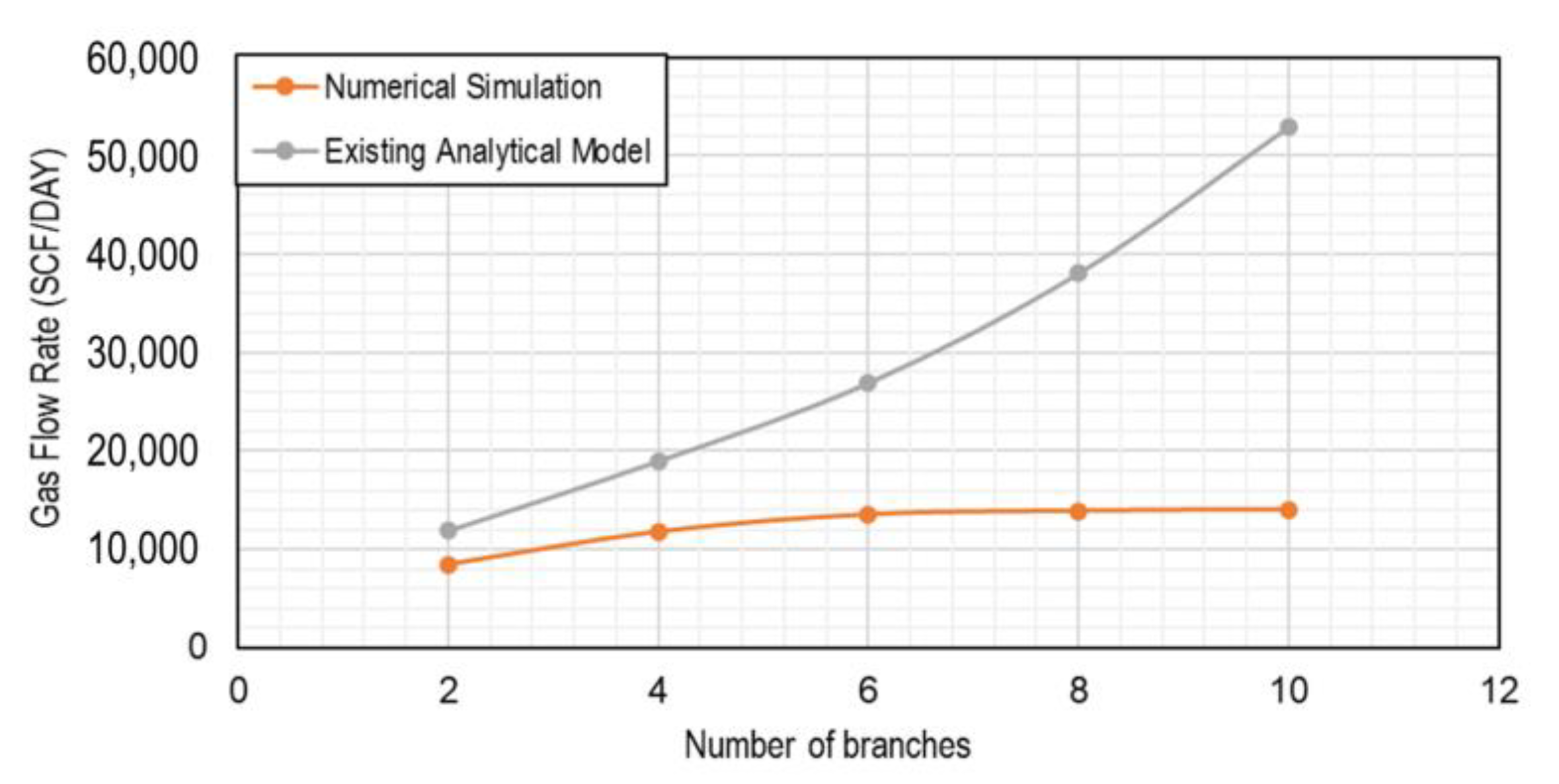
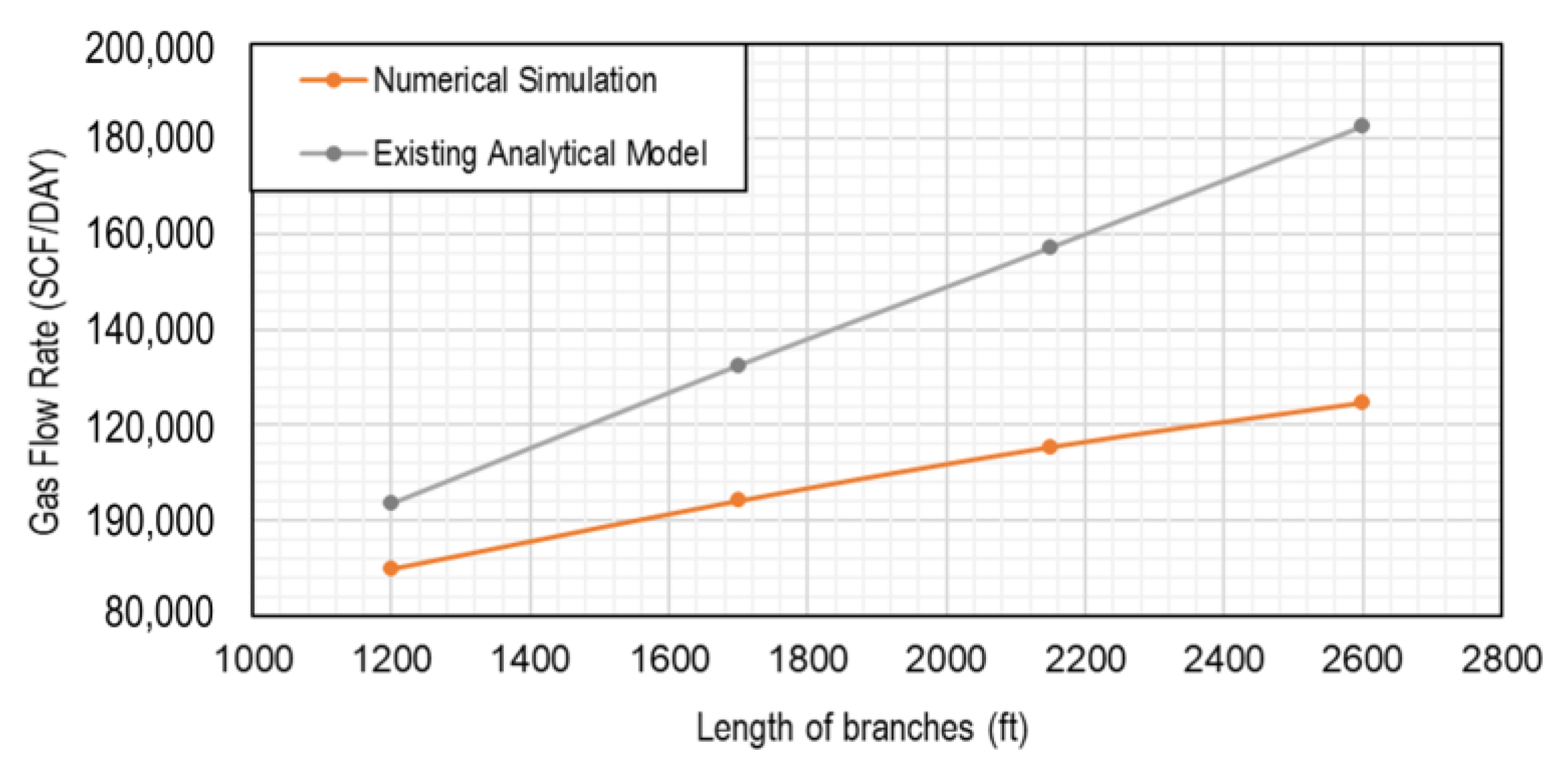
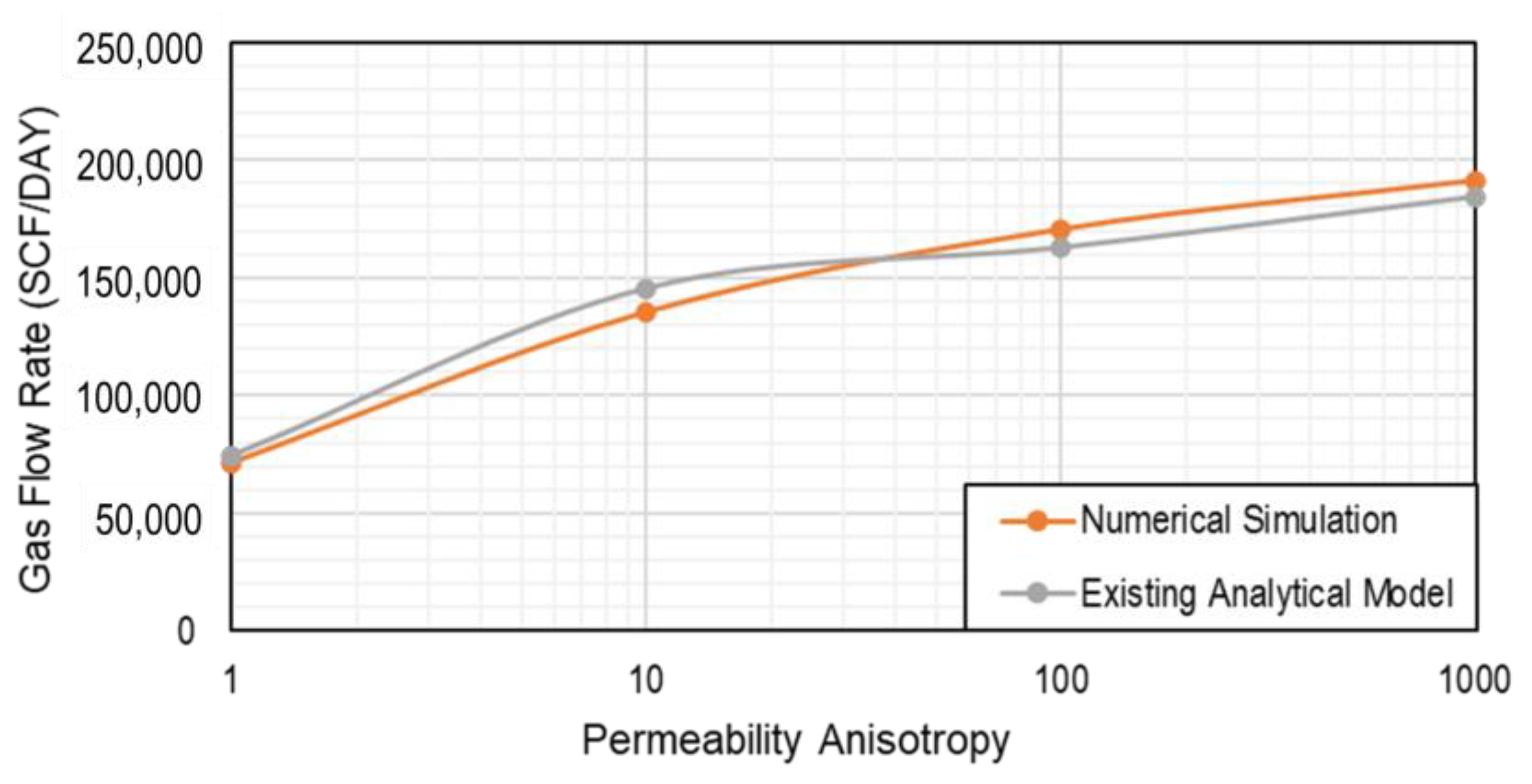
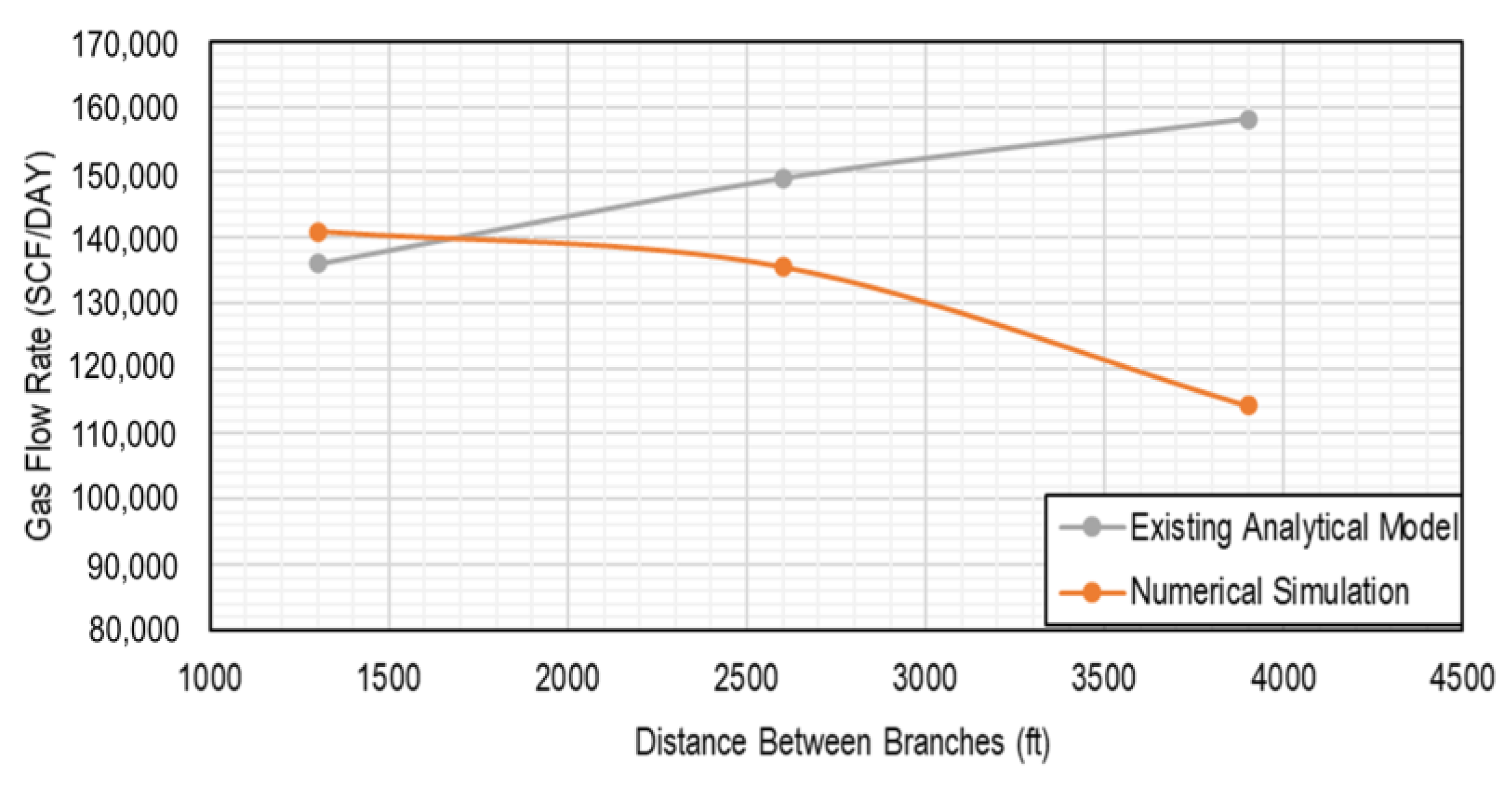
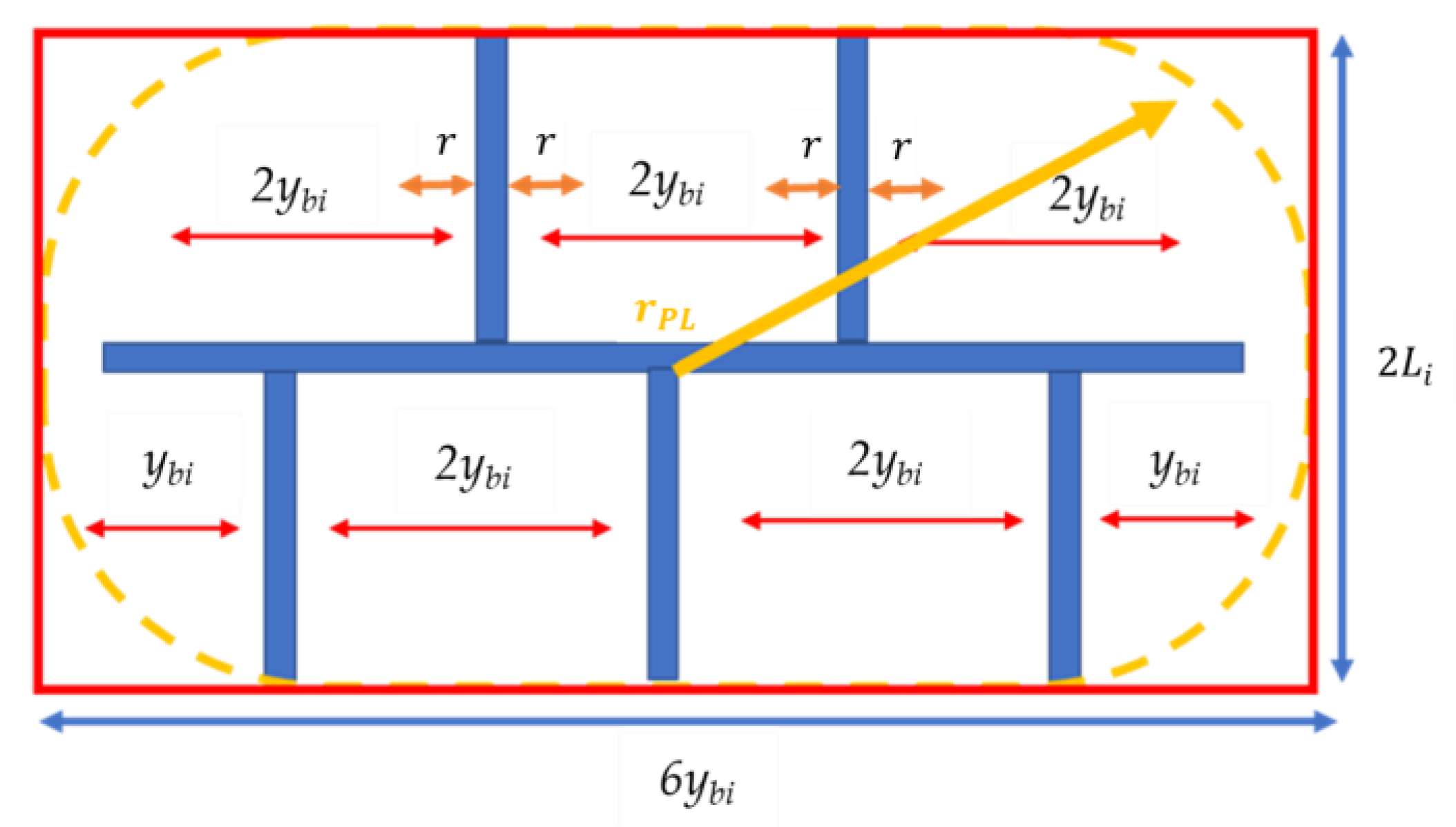
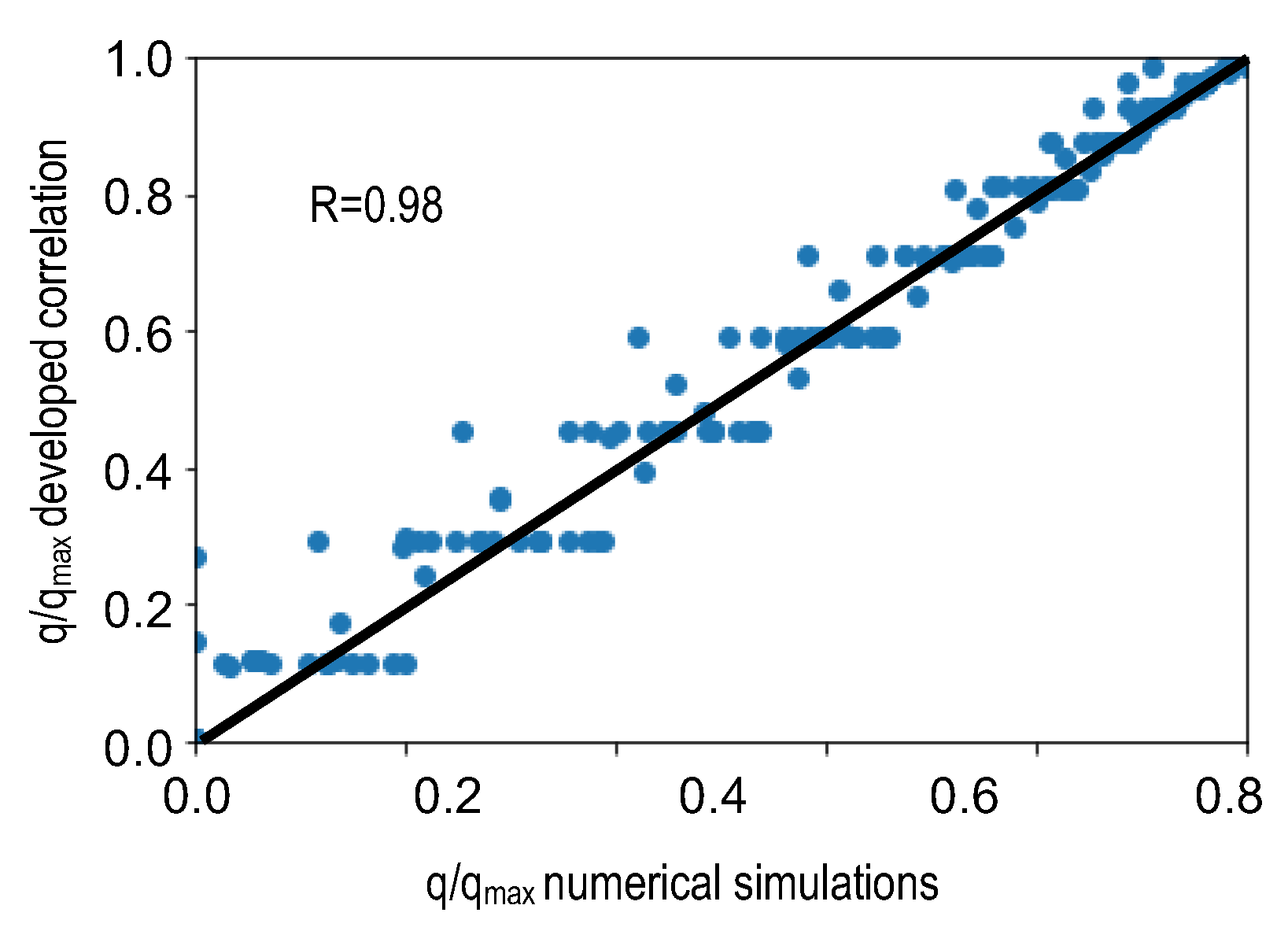
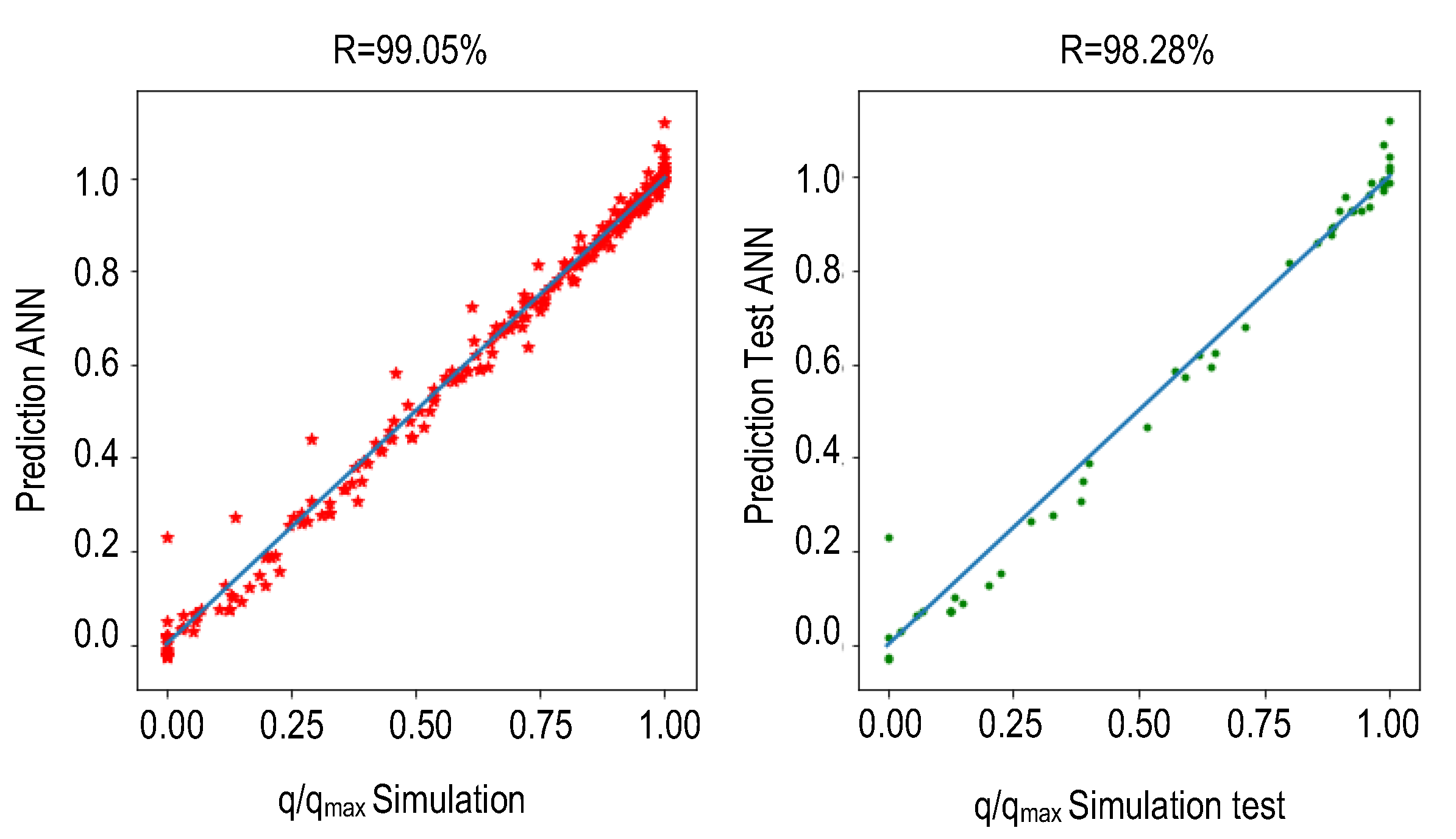
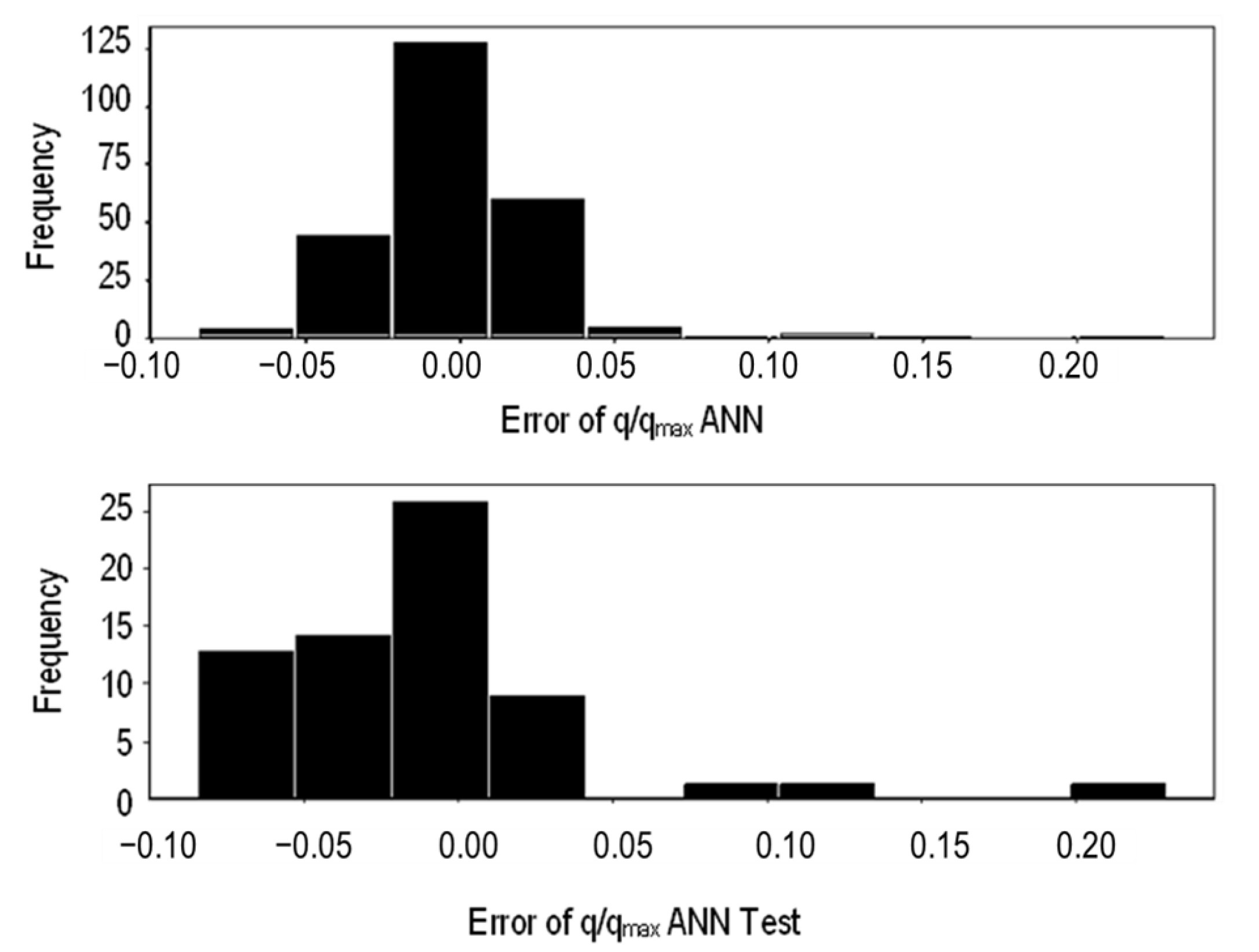
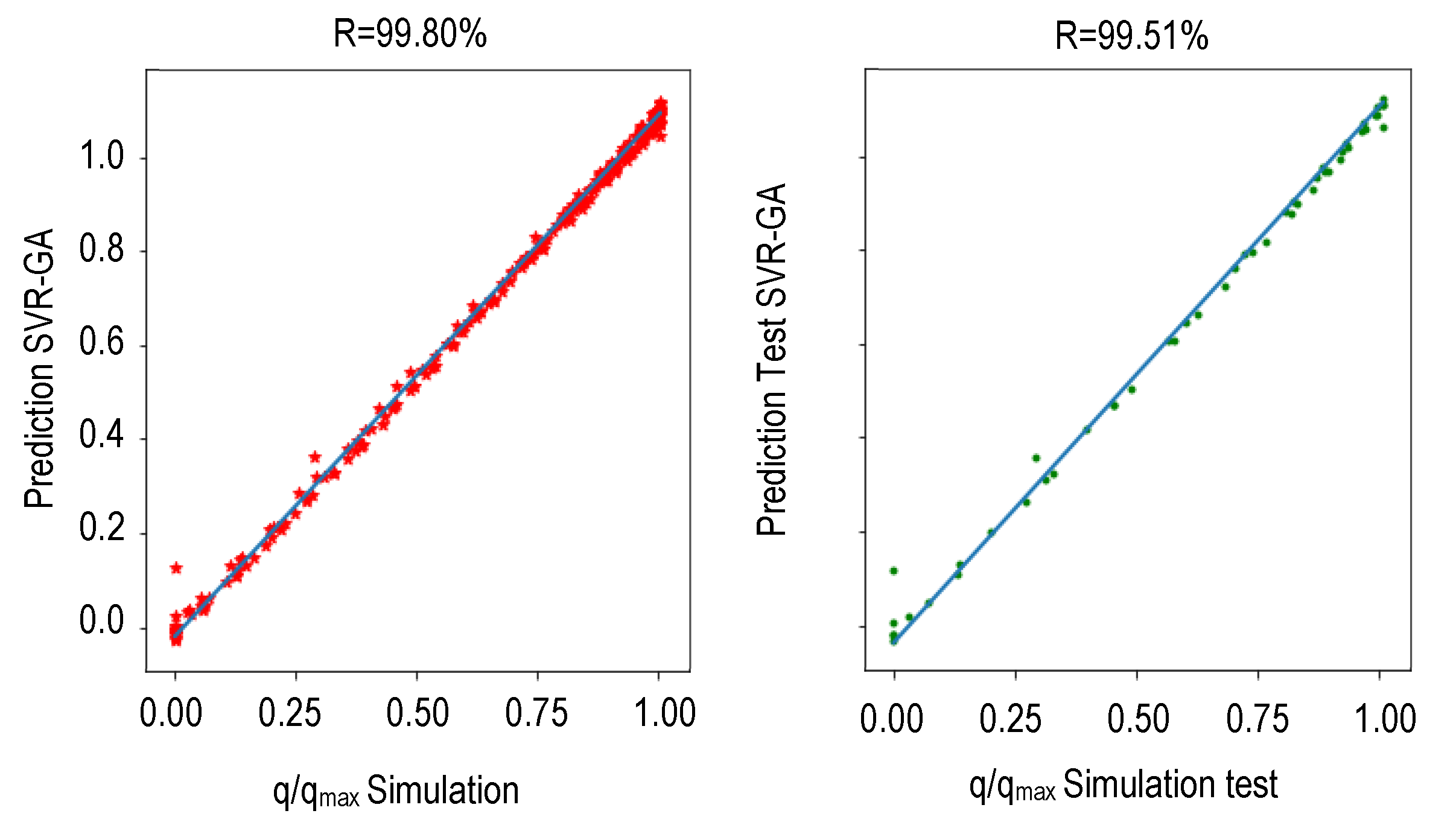
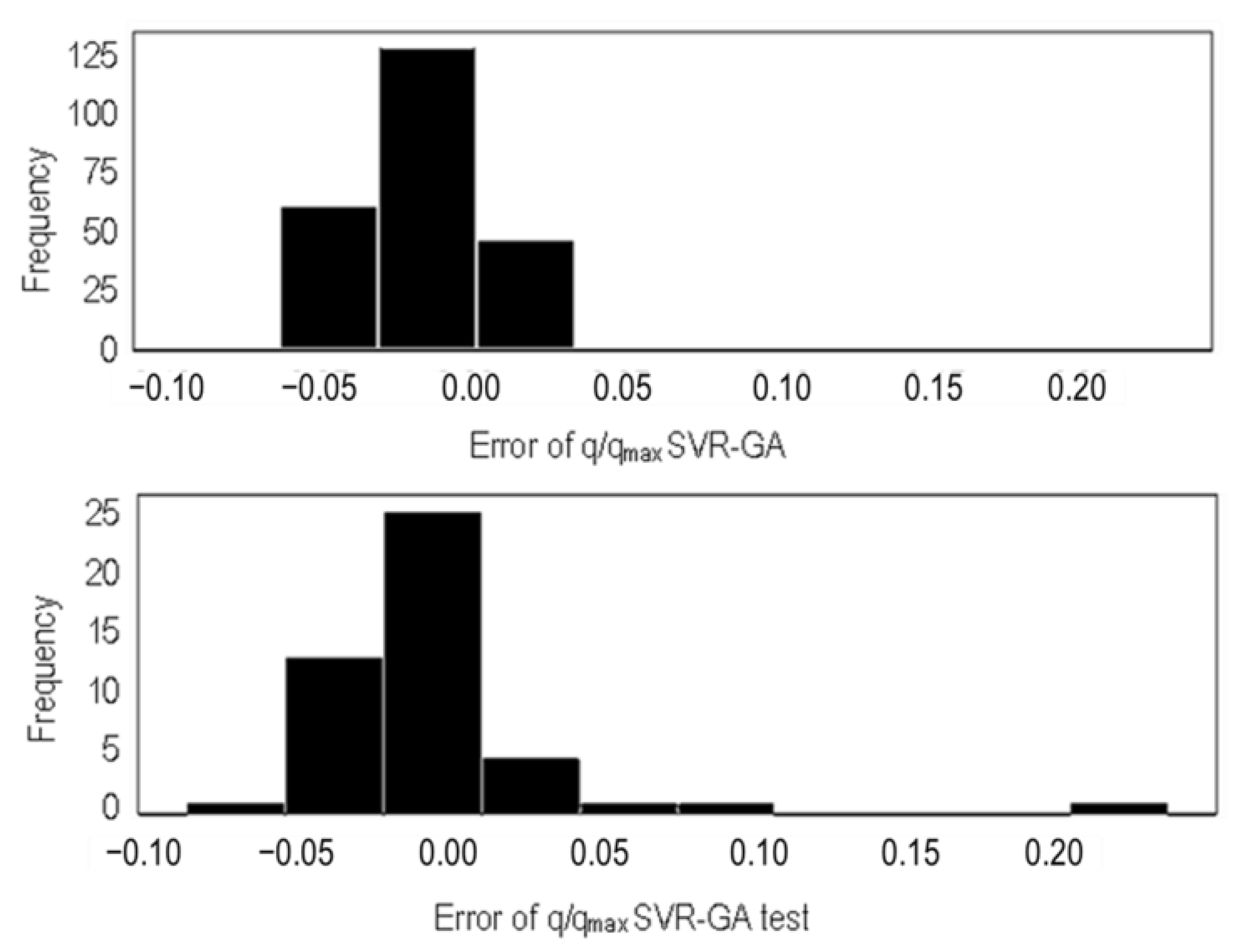
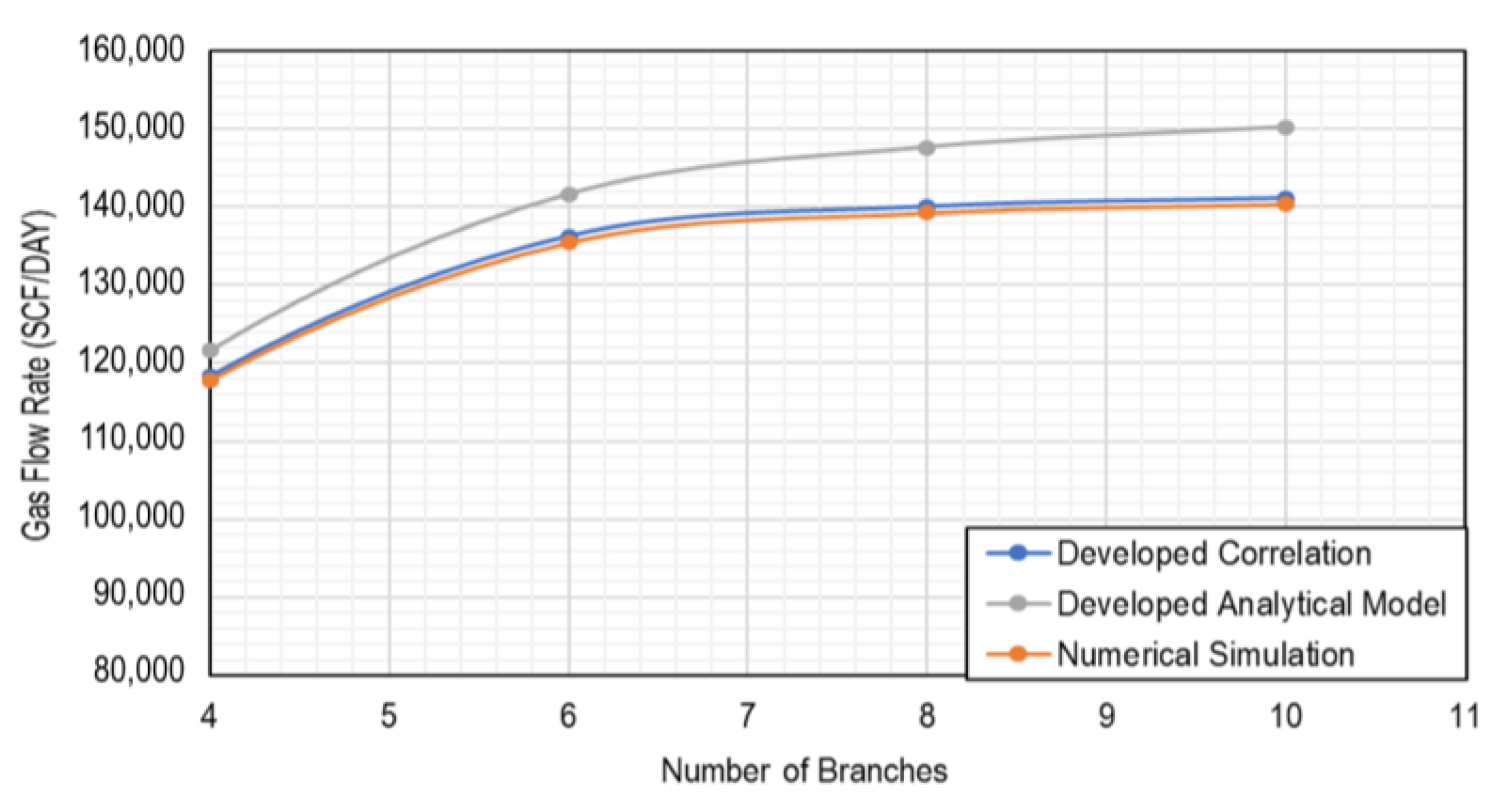
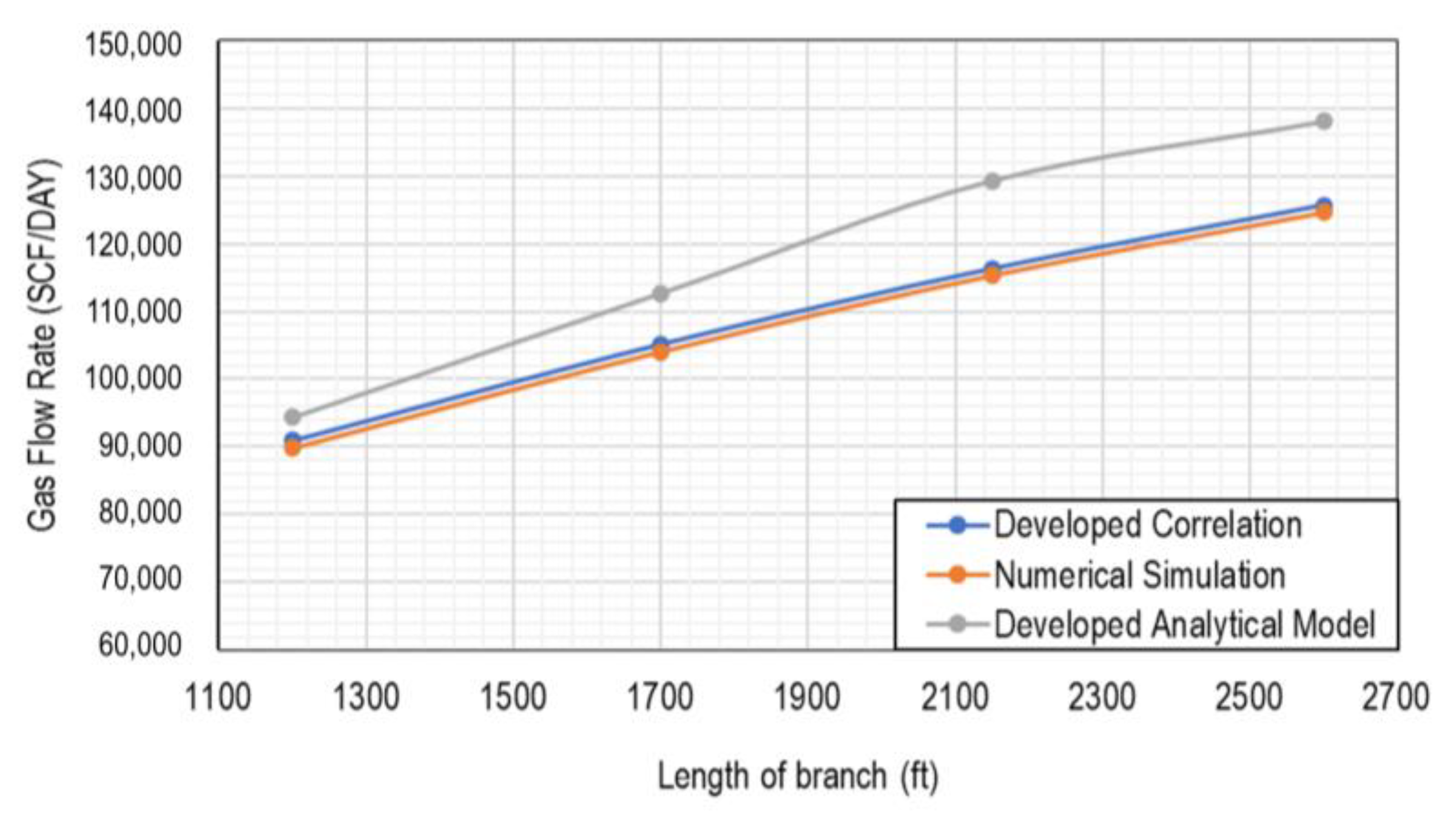
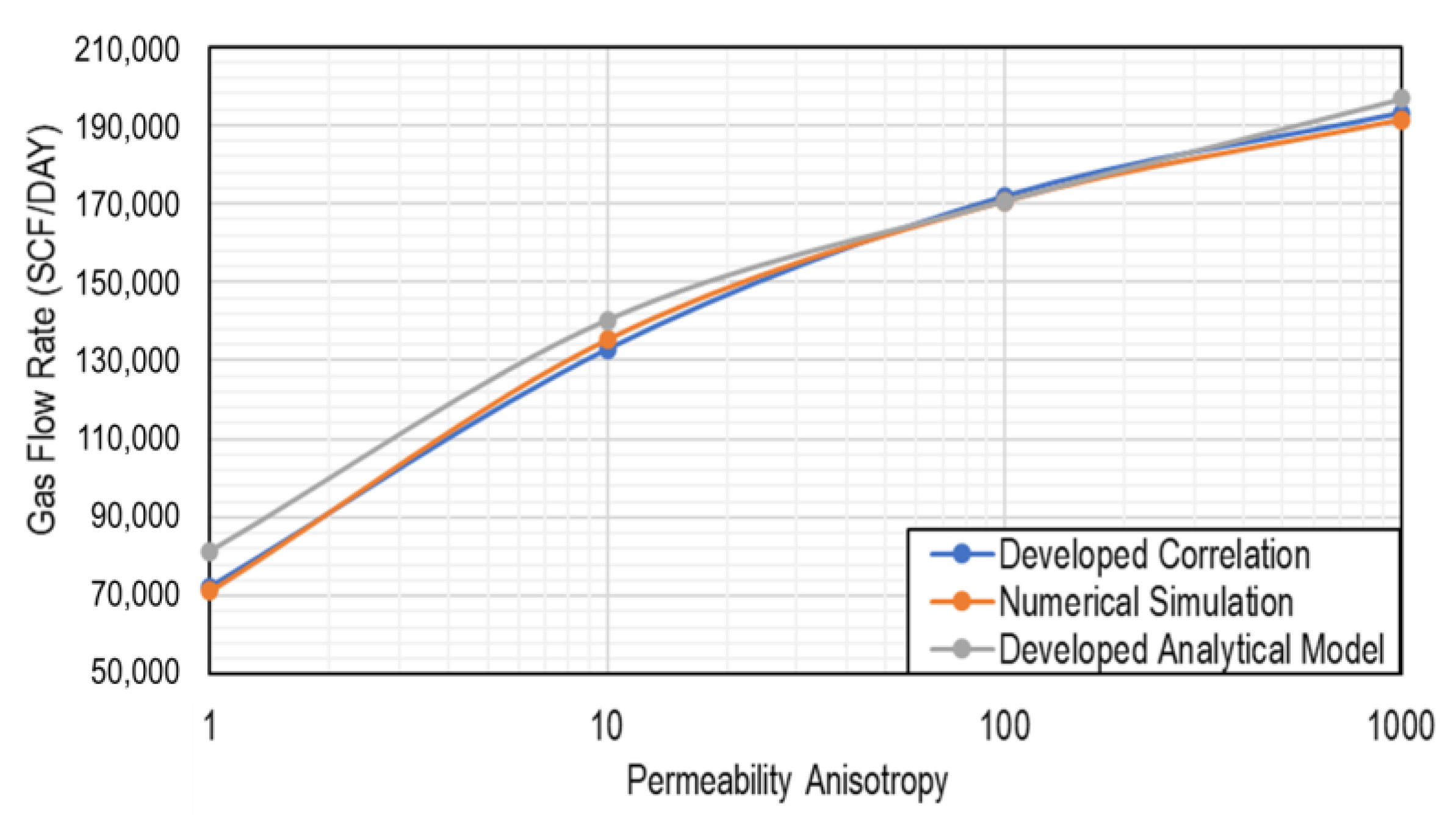
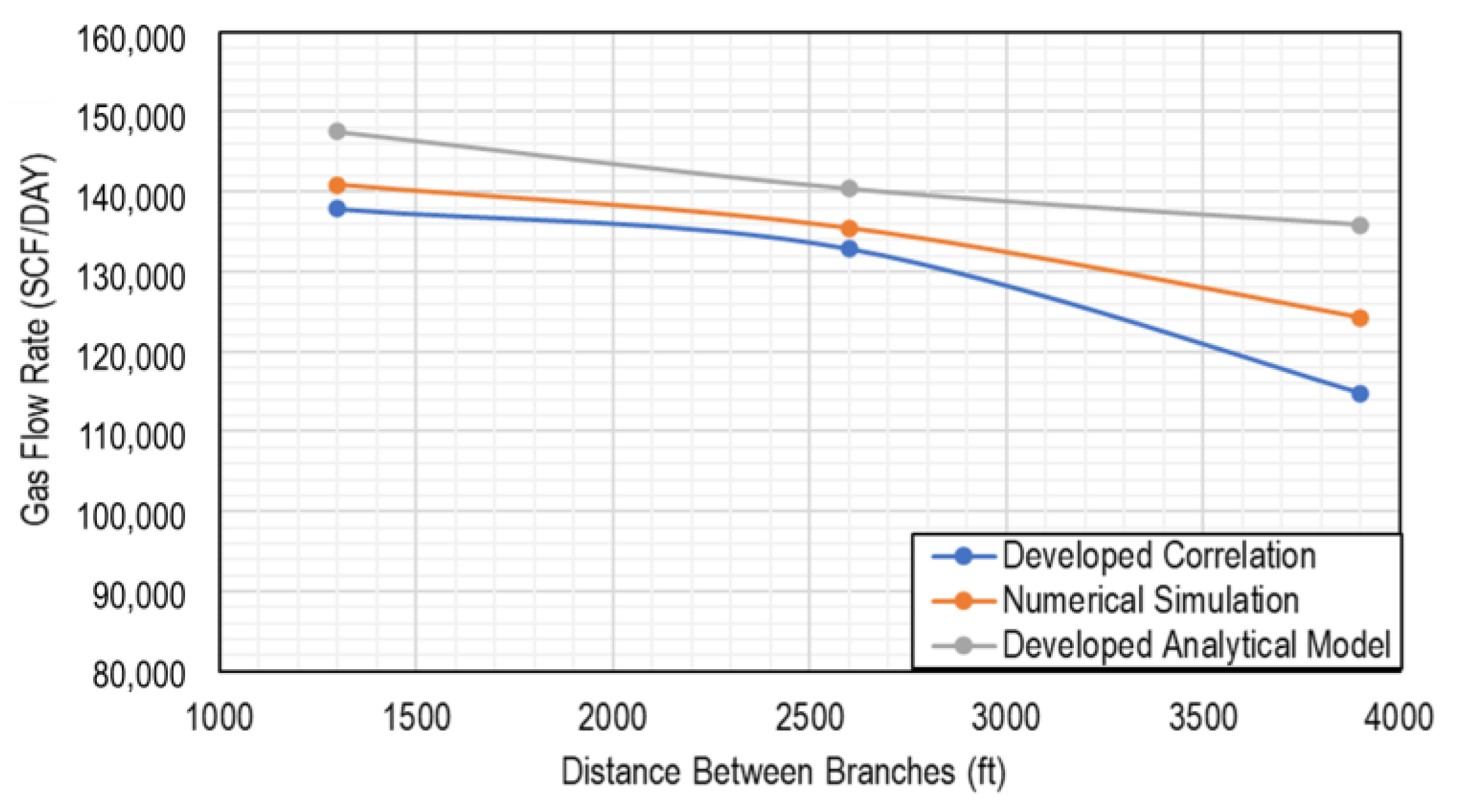
| c | Production Rate (SCF/DAY) | Well Pressure (psi) | Permeability Ratio (kH/kV) | Number of Branches | Distance between Adjacent Branches (ft) | Branches Length (ft) |
|---|---|---|---|---|---|---|
| Maximum | 197,900 | 4800 | 1000 | 14 | 5200 | 3100 |
| Minimum | 0 | 14.7 | 1 | 2 | 1300 | 700 |
| Mean | 81,861 | 2360 | 61 | 7 | 2724 | 2760 |
| Standard Deviation | 48,713 | 1552 | 212 | 2.5 | 685 | 693 |
| Coefficient of variation | 60 | 66 | 346 | 38 | 25 | 25 |
| Parameter | Estimated Value |
|---|---|
| a | −5.61989377 × 102 |
| b | 59.4495457 |
| c | −1.35260055 × 102 |
| d | −1.16891882 |
| e | −6.94846204 × 10−2 |
| f | 1.91538556 |
| g | −4.51686871 × 10−4 |
| h | −1.44650462 × 102 |
| C | Gamma γ | Epsilon ε |
|---|---|---|
| 2770.073549607837 | 0.20169072542497024 | 0.020918583247214607 |
| Parameter | Value |
|---|---|
| The size of the population | 30 |
| Maximum number of generations | 8 |
| Crossover probability | 100 |
| Mutation probability | 20 |
| Approach | R2 | Average Error (RMSE) |
|---|---|---|
| Existing Analytical model | 32.11% | 0.791 |
| Developed analytical model | 94.39% | 0.104 |
| Developed correlation | 98.56% | 0.067 |
| Developed ANN Model | 99.05% | 0.033 |
| Developed SVR-GA Model | 99.80% | 0.014 |
Disclaimer/Publisher’s Note: The statements, opinions and data contained in all publications are solely those of the individual author(s) and contributor(s) and not of MDPI and/or the editor(s). MDPI and/or the editor(s) disclaim responsibility for any injury to people or property resulting from any ideas, methods, instructions or products referred to in the content. |
© 2023 by the authors. Licensee MDPI, Basel, Switzerland. This article is an open access article distributed under the terms and conditions of the Creative Commons Attribution (CC BY) license (https://creativecommons.org/licenses/by/4.0/).
Share and Cite
Ouadi, H.; Laalam, A.; Hassan, A.; Chemmakh, A.; Rasouli, V.; Mahmoud, M. Design and Performance Analysis of Dry Gas Fishbone Wells for Lower Carbon Footprint. Fuels 2023, 4, 92-110. https://doi.org/10.3390/fuels4010007
Ouadi H, Laalam A, Hassan A, Chemmakh A, Rasouli V, Mahmoud M. Design and Performance Analysis of Dry Gas Fishbone Wells for Lower Carbon Footprint. Fuels. 2023; 4(1):92-110. https://doi.org/10.3390/fuels4010007
Chicago/Turabian StyleOuadi, Habib, Aimen Laalam, Amjed Hassan, Abderraouf Chemmakh, Vamegh Rasouli, and Mohamed Mahmoud. 2023. "Design and Performance Analysis of Dry Gas Fishbone Wells for Lower Carbon Footprint" Fuels 4, no. 1: 92-110. https://doi.org/10.3390/fuels4010007
APA StyleOuadi, H., Laalam, A., Hassan, A., Chemmakh, A., Rasouli, V., & Mahmoud, M. (2023). Design and Performance Analysis of Dry Gas Fishbone Wells for Lower Carbon Footprint. Fuels, 4(1), 92-110. https://doi.org/10.3390/fuels4010007









